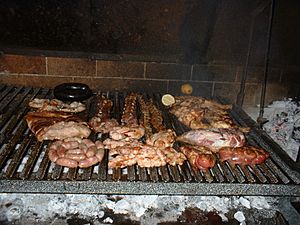Argentine cuisine facts for kids
Argentine cuisine is a delicious mix of different cultures! It started with the Indigenous peoples of Argentina who used foods like humita (a corn dish), potatoes, cassava, peppers, tomatoes, beans, and yerba mate. Then, the Spanish arrived and brought their Mediterranean cooking styles. This created a unique blend of food from the criollos (early Spanish settlers and gauchos), Indigenous people, and even some sub-Saharan African influences. Later, many Italian and Spanish immigrants came to Argentina in the 1800s and 1900s. They added their own popular dishes like pizza, pasta, and Spanish tortillas.
Beef is a huge part of the Argentine diet because the country produces so much of it. People in Argentina eat a lot of beef! In the 1800s, they ate about 180 kg (397 lb) per person each year. Today, it's still around 67.7 kg (149 lb) per person.
While asado (Argentine barbecue) is a national favorite, Argentina is a big country with many different cultures. This means there are lots of other local dishes to enjoy!
Argentina welcomed many immigrants, about 6.6 million, which was the second-highest number in the world after the United States. These new arrivals greatly influenced Argentine food.
Argentine people love to eat and share meals. Getting invited to dinner at someone's home is a sign of friendship. Sunday family lunch is often the most important meal of the week, usually featuring asado or pasta.
Making homemade food like French fries, patties, and pasta for special occasions or friends is also common. It's a way to show you care.
Argentine restaurants offer many choices, from fancy international places to bodegones (hidden, inexpensive traditional taverns) and casual bars with affordable dishes.
Contents
History of Argentine Food
Long before Europeans arrived, Amerindians lived in Argentina for thousands of years. They mainly grew crops like maize (corn), potatoes, beans, quinoa, and squash. They also hunted, gathered, and fished.
Amerindian groups got their food in different ways:
- Hunters and gatherers lived in the Patagonia, Pampa, and Chaco regions.
- Farmers in the northwest, Cuyo, and Cordoba mountains grew squash, melons, and sweet potatoes. These groups were influenced by the Andean-Incan traditions.
- Farmers in the Mesopotamia plains belonged to the Guaraní culture.
Spanish settlers came to Argentina in 1536. They started farms called chacras where Amerindians worked. The arrival of Europeans brought new foods from the Old World to Argentina, like wheat, grapevines, figs, and various fruits. During this time, cattle, goats, and pig farming were also introduced, which became the start of Argentina's huge Argentine beef industry.
Between 1853 and 1955, about 6.6 million immigrants arrived in Argentina. They came from Europe (especially Italy, Wales, Germany, and Switzerland), the Near and Middle East, Russia, and Japan. These immigrants helped Argentine cuisine grow by bringing new foods and encouraging more farming.
In the 1800s, beef, fish, and bird meats were cheap and easy to find. However, grains and wheat were scarce, so bread was very expensive. Common dishes included soups with pork, cooked partridge with legumes, spinach bread, beef slices, and lamb stew. Popular spices were garlic, parsley, and pepper.
By the early 1900s, Argentine food changed a lot due to new immigrants. Most came from Italy and Spain. Italians introduced pizza and many pasta dishes like spaghetti and lasagna. British, German, Jewish, and other immigrants also brought their cooking styles. The British even started the tradition of teatime. All these cultures shaped the dishes of Argentina.
Italian cuisine became a big part of Argentine food. The La Boca neighborhood in Buenos Aires was a major Italian area, and from there, Italian ingredients and eating habits spread. Different pastas like tallarines (long noodles), gnocchi, ravioli, and cannelloni filled with ricotta cheese became popular. So did pizza, fainá (a chickpea flour bread), and milanesas (breaded meats). Italians also influenced how Argentines made ice cream, fish, and shellfish.
Spanish immigrants also left their mark, making nuts, tomato sauce, pesto, olives, and olive oil popular. They also helped spread wine drinking. At the same time, other global foods like saffron, cod, different beans, chickpeas, and chocolates arrived in Argentina.
Typical Argentine Foods

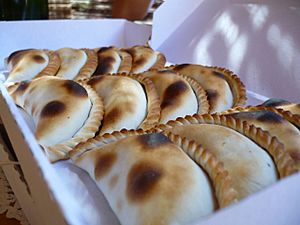
Most parts of Argentina are famous for their beef. Grilled meat from the asado (barbecue) is a main dish, especially steak and beef ribs. The word asado itself often refers to long strips of beef ribs.
Other popular items cooked on the grill include chorizo (pork sausage), morcilla (blood sausage), chinchulines (small intestines), mollejas (sweetbread), and other parts of the animal.
In Patagonia, people eat more lamb and chivito (goat) than beef. Whole lambs and goats are often cooked over an open fire, a method called asado a la estaca.
The most common sauce for asado is chimichurri. It's made with herbs, garlic, and vinegar. Unlike other countries, Argentines don't usually add chili to their chimichurri, but they do use a milder red pepper called ají molido.
Breaded and fried meats called milanesas are eaten as snacks, in sandwiches, or with mashed potatoes.
Empanadas are small pastries filled with meat, cheese, sweet corn, or other tasty ingredients. They are common at parties and picnics, or as starters. They have a special folded edge called a repulgue, which not only looks nice but also helps identify the filling when you order many different kinds. Empanadas are a very important food in Argentina because there are so many varieties.
Today's empanadas come from a Spanish dish from the 1400s. Travelers used easy-to-carry bread filled with different ingredients. Over time, it became a popular food and spread worldwide.
Argentines also eat vegetables and salads. Tomatoes, onions, lettuce, eggplants, squashes, and zucchini are common side dishes.
Italian foods like pizza and pasta are eaten as often as beef. Fideos (noodles), tallarines (like fettuccine and tagliatelle), ñoquis (gnocchi) are traditionally eaten on the 29th of each month. Ravioles and canelones (cannelloni) can be bought fresh in many cities. Italian-style ice cream is very popular and sold in large shops. Other Italian foods include polenta, tarta pascualina, and pastafrola.
In Chubut, the Welsh community is known for its teahouses. They offer scones and torta galesa, which is similar to torta negra.
A fosforito is a ham and cheese sandwich made with puff pastry. Sandwiches de miga are delicate sandwiches made with thin, crustless white bread, thinly sliced cured meat, cheese, and lettuce. People often buy them from home cooks for a light evening meal.
Dulce de leche is a sweet, creamy paste that is a national favorite. It's used to fill cakes and pancakes, spread on toast for breakfast, or served with ice cream. Alfajores are another key sweet. These are shortbread cookies with dulce de leche or fruit paste in the middle, often covered in chocolate. The "policeman's" or "truck driver's" sweet is cheese with quince paste (dulce de membrillo). Dulce de batata is made from sweet potato/yam; eating this with cheese is called Martín Fierro's sweet. Ice cream shops, or heladerias, are very popular, especially in Buenos Aires. Argentine ice cream comes in many flavors and is very smooth, like Italian gelato.
Apples, pears, peaches, kiwifruits, avocados, and plums are major exports from Argentina.
A traditional Argentine drink is an infusion called mate. The name comes from the hollow gourd it's usually drunk from.
The mate (gourd) or small cup is filled about three-quarters with yerba mate, which are the dried leaves and twigs of the Ilex paraguariensis plant. The drink is quite bitter and is sipped through a metal or cane straw called a bombilla. Mate can be sweetened with sugar or flavored with herbs or dried orange peel.
Hot, but not boiling, water is poured into the gourd, drunk, and then refilled. Since the gourd is mostly filled with leaves, each refill makes a small drink, but you can refill it many times before the yerba loses its flavor. In small groups, it's common to pass one mate around, with one person refilling it. You usually don't say "thank you" every time it's refilled; a final gracias (thank you) means you've had enough.
Drinking mate together is an important social custom. Mate cocido uses the same leaves, but they are boiled and served like tea, often with milk and sugar.
Other typical drinks include wine (sometimes with soda water added). Tea and coffee are also very popular. Quilmes is the national brand of pale lager beer, named after the town of Quilmes, Buenos Aires, where it was first made.
Ingredients Used in Argentine Food
Argentine cuisine uses local cereals, grains, oil seeds, fruits, and vegetables, as well as meat.
Meat products have been very important in Argentina since the 1500s. The country is known for producing and eating a lot of beef, pork, and poultry. In southern areas, people often raise sheep and lamb, and fish for shellfish, crustaceans, molluscs, and salmonides.
Because there are so many cattle, Argentina has a well-developed dairy industry. They make products like cow, sheep, and even camel milk, dulce de leche, and yogurt. Some Argentine cheeses include reggianito, sardo, provoleta, and cremoso. Argentina also produces a lot of dried fruits, olives, different types of oils, and spices.
In the Mesopotamia region, river fish like silverside, surubi, dorado, or boga are common.
Regional Differences in Argentine Cuisine
Argentine cuisine is strongly influenced by its European roots and changes from one region to another. However, asado, dulce de leche, empanadas, and yerba mate are found all over Argentina. In many parts of the country, food is prepared differently, and unique dishes are made, sometimes even with influences from pre-Columbian times, especially in the Northwest.
Central Region and La Pampa
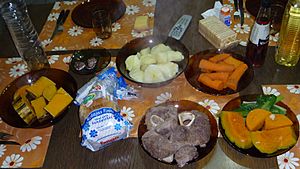
This region includes the city of Buenos Aires, Buenos Aires Province, Córdoba, La Pampa, Santa Fe, and Entre Ríos.
This area, especially big cities like Buenos Aires, Rosario, and Córdoba, welcomed many European immigrants. Most were from Italy and Spain, but also from Germany, Switzerland, and the Middle East. Because of this, dishes like pasta, pizza, pucheros (stews), croquetas (fritters), sauces, embutidos (sausages), and chicken and meat dishes became very common. This region also developed a strong tradition of bread-making, desserts, pastries, and dairy products.
These dishes have developed a special Argentine touch. For example, Argentine pasta includes many types like spaghetti, fusiles (fusilli), ñoquis (gnocchi), ravioli, cintas (pasta ribbons), and lasagne. There are also Argentine-made sorrentinos, agnolottis (agnolotti), canelones (cannelloni), and fetuchines (fettuccine).
Pizza, made with thin or sometimes thick, high-rising doughs, with or without cheese, cooked in an oven or a la piedra (on a stone oven), and topped with many ingredients, can be found almost everywhere. In Buenos Aires, Rosario, and Córdoba, pizza is often served with fainá, a chickpea-flour bread placed on top of the pizza slice. People say Argentine pizza is unique because it mixes Italian and Spanish cultures. In the early 1900s, immigrants from Naples and Genoa opened the first pizza places, though Spanish people later owned most of them.
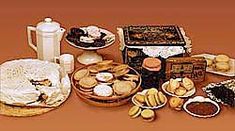
Bread products are eaten all over the country. The strong tradition of bread, pastry, and dessert making comes from mixing different nationalities' products. Bakeries sell many types of bread, cookies, cakes, and pastries. Pastries are like rolls, often made with butter or fat, and can be plain or filled with dulce de leche, milk, jam, crema pastel (custard), or quince or apple jelly. The most popular pastry is the medialuna (literally "half-moon"), which is similar to a French croissant. Sandwiches de miga are another type of bread product. They are made with thin layers of white bread (usually crustless) and filled with things like ham and cheese, or more fancy combinations like raw ham, tomatoes, olives, hard-boiled eggs, tuna, lettuce, and red pepper.
Desserts and sweets are usually filled or covered with dulce de leche. You can eat dulce de leche by itself, or on top of cakes, alfajores, panqueques (crepes), and pastries, or as a topping for flan de leche. Chantilly cream (whipped cream) is also widely used in sweets and desserts. Cakes, sponge cakes, and puddings are very popular. Italian ice cream in this region has also developed unique local flavors while keeping its traditional Italian style.
Although asado is eaten everywhere, it started in the Pampas. It includes many types of meat. People usually start with achuras (offal), morcilla (blood sausage), and sometimes provoleta (a piece of provolone cheese cooked on the grill with oregano). Then comes choripán (a spiced sausage in bread), and finally meats like asado de tira (short ribs), vacío (flank steak), lomo (tenderloin), colita de cuadril (rump), matambre (rolled stuffed steak served cold), and entraña (hanger steak). The list goes on and on! Cabrito al asador (roast kid or goat) is often eaten in the province of Córdoba.
Northwest and Cuyo Regions
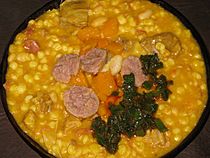
This region includes the provinces of Jujuy, Salta, Catamarca, Tucumán, Santiago del Estero, La Rioja, San Juan, Mendoza, and San Luis. It is the most influenced by Native Americans, and its foods are closely linked to the Andean-Incan traditions. When making regional dishes, potatoes and corn or wheat are almost always used, along with quinoa (a grain common in Incan cooking), peppers, squashes, tomatoes, and in some provinces, beans. The most famous dishes are humita and tamal, where corn husks are filled with corn, seasonings, or meat.
This region is the best place to try empanadas, especially those filled with meat. There are many tempting varieties, like the meat empanada, the salteña (also with potatoes), or the empanada tucumana (stuffed with matambre and cut with a knife). There are also empanadas made with cheese. Empanadas are individual-sized savory pastries that can be fried or baked and are usually eaten by hand.
Stews like locro, carbonada, pollo al disco, and cazuelas (casseroles) are also typical dishes in this region. They often include pumpkin or potato pudding stuffed with meat.
There are also local food festivals here. For example, in Salta, they have a festival for a locally grown bean similar to Edamame. During this festival, traditional corn and bean dishes are celebrated, and there are even competitions to see who can eat a certain number of beans the fastest.
Mesopotamia Region

The green and humid area of northeastern Argentina, known as Mesopotamia, includes the provinces of Chaco, Corrientes, Misiones, and Formosa. This area is also heavily influenced by Native Americans, especially the Guaraní tribe. With many rivers and shores, it offers a wide variety of fish like dorado, pacú, surubi, boga, and silverside.
Cassava is widely grown here and is a common ingredient in the region's dishes, such as chipá (cassava and cheese bread). Cassava is also cooked alone, boiled or fried, often as a side dish for asado and empanadas. Other similar meals made with manioc, corn, cheese, and sometimes meat include mbeyú, chipá avatí, sopa paraguaya, sopa correntina, chipa solo or chipá con carne, el quibebé, el borí borí, chipá guasú o pastel de choclo, mbaipy, and chipá mbocá o chipá caburé. Chipá from cassava is often eaten for breakfast with yerba mate (prepared with hot water) or café con leche (coffee with milk). Sopa Paraguaya and pastel/Carta de Choclo are eaten for lunch or dinner. For sweets, Papaya (called mamón in Argentine Spanish) jam is typical in the north of this region.
The most important product from this region is yerba mate. It's drunk all over the country. In this area, because of the high temperatures, it's common to prepare mate with cold water, which is called tereré.
Patagonia Region
The large southern region of Patagonia includes the provinces of Neuquén, Río Negro, Chubut, Santa Cruz, and Tierra del Fuego. This area also covers the Antarctica and Southern Atlantic Islands. Their most typical foods include fish and seafood from the sea and rivers, and products from the many sheep farmed there.
You can catch marine species like salmon, spider crabs, squid, and other shellfish and molluscs in the Atlantic Ocean. There are also trout in the rivers.

Many berries grow in this area, including cherries, bilberries, strawberries, rosa mosqueta, and elders. These are often made into jams.
The Northern and Central European settlers in this region have developed a large production of chocolate and its products. Viennese and German cuisine and pastries are also common in this region.
Mutton and lamb, along with wild boar and venison, are common meat dishes in Patagonia. Smoked products are also typical of the southern region, including smoked salmon, stag, wild boar, and pheasant.
Patagonia has been greatly influenced by the tribes who lived there long before Europeans arrived, especially the Mapuches and the Araucanos. A typical dish from the Araucano people is the curanto (meaning "hot stone"). To make it, a fire is built in a hole about 150 cm (59 inches) deep in the ground, and stones are heated in it. A bed of nalca or maqui leaves is placed on top of the hot stones, and then ingredients are added. The ingredients can vary but might include beef, lamb, pork, chicken, Argentine chorizos (pork sausages), potatoes, sweet potatoes, apples, and hollowed squashes filled with cheese, cream, and peas. The food is covered with leaves and damp cloths to keep the heat in, and then covered with a lot of soil.
See also
 In Spanish: Gastronomía de Argentina para niños
In Spanish: Gastronomía de Argentina para niños


